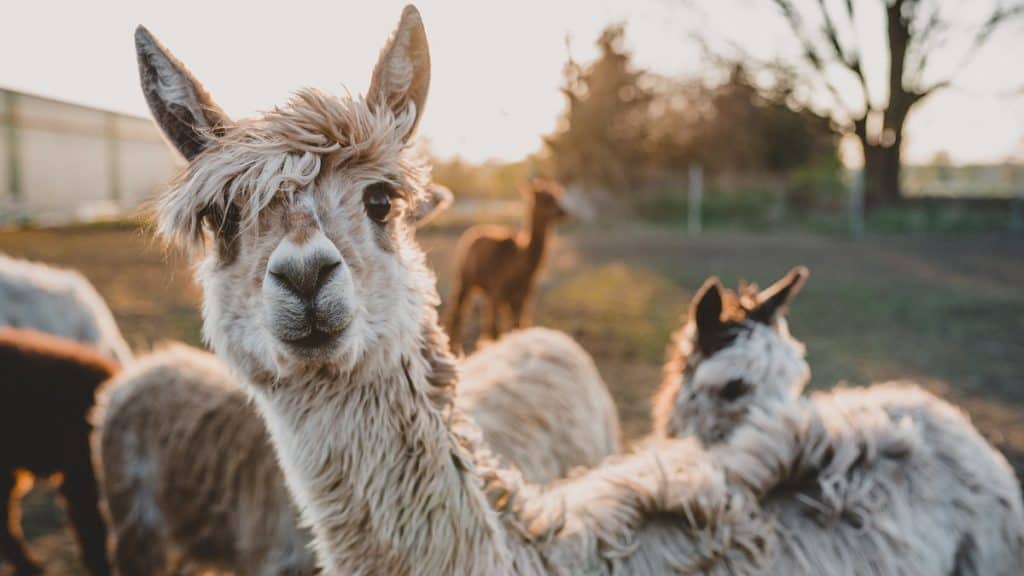
Alpacas are adorable and charming animals with irresistibly soft and fluffy fur. So, it is no surprise that people would want to have one of their own. That is one of the reasons why alpaca ownership has become increasingly popular over the years. But is having a pet alpaca all it’s cracked up to be? This article will look at if it is possible to have an alpaca as a pet and what is needed to care for one properly or if you are better off with an alpaca stuffed animal.
Types of alpacas and where they live
Alpacas are herbivorous, camelid mammals that live primarily in high-altitude areas (3,500 to 5,000 meters above sea level) of South America. Camelids are even-toed ungulates from the order Cetartiodactyla, along with species like pigs, deer, cattle, and antelopes. Even-toed ungulates are hooved animals that bear weight equally on two of their five toes (the third and the fourth one).
Alpacas are part of the Lama genus, consisting of four species – llama, alpaca, vicuna, and guanaco. Llamas and alpacas often get mistaken for one another. Both look similar and are domesticated from their wild relatives, the vicuna and guanaco. However, one of the main differences is their size and purpose. Alpacas are often noticeably smaller than llamas and are bread primarily for fibre. Alpaca fibre is sold and used to make knitted and woven items. Llama fibre is also sold, but llamas are widely used as a meat and pack animal.
There are currently two extant breeds of alpaca – the Suri and Huacaya. Both species live primarily in the Andes of Southern Peru but can be found in Western Bolivia, Ecuador, and northern Chile.
The breeds are classified based on their fibres. Huacaya fleece is thick, curly, dense, and soft. In contrast, Suri alpacas have thinner, cylindrical locks that resemble dreadlocks. They also differ based on distribution, with Huacaya breeds making up approximately 90 per cent of the entire alpaca population.
What do you need to take care of an alpaca?
Alpacas may not be as high maintenance as other exotic pets, but responsible owners must meet their dietary, habitat, and lifestyle requirements for them to thrive. Learn more about these requirements below.
What does an alpaca eat?
Alpacas are herbivorous, grazing animals that predominantly eat pasture grass, hay, or silage. On average, alpacas eat about 1.5 per cent of their body weight daily in grass or hay, so owners must be able to provide the necessary quantities.
Grass and hay are widely found across the world, so meeting dietary requirements may be less challenging than with other exotic pets. Food sources can be found easily and are often readily available on farms or ranches. However, it will cost around $100 each month to feed one alpaca.
Feeding is low maintenance since alpacas feed themselves. However, they can sometimes be picky about their food sources. Therefore, finding food they like may take trial and error. Some owners may supplement the alpaca’s diet with pellets made from other vegetable and fruit sources for added nutrients, which would add to the cost.
It is advised to purchase an alpaca that is at least six months old. Before this age, they could only have their mother’s milk. Other milks (e.g., cow) will not suffice, as the fat and sugar contents are often much higher than in alpaca milk.
Alpacas drink approximately two to five gallons of water daily, more on hot days. Therefore, they will need a constant source of freshwater. Investing in an automatic watering system is a good idea, especially if you plan to own several alpacas.
What is an alpaca’s habitat?
Alpacas live primarily in temperate climates on mountains with high altitudes. However, they are not limited to these conditions. They can live almost anywhere with adequate space to move and graze. One acre of land is suggested for four to five alpacas (it is recommended to keep at least three) to keep them comfortable.
Alpacas are also resilient to cold temperatures since their fur is insulated. Nonetheless, it is advised to provide sheltered areas in their enclosures to shield themselves from the sun and unwanted weather. Shelter space should be around 4 square meters per alpaca. Fencing is also recommended to keep them protected from predators and other animals.
Overall, habitat requirements are not much different than other farm animals, so it may be simpler to accommodate alpacas in ranching spaces. However, non-farmers must ensure there is adequate land to house more than one alpaca.
What is an alpaca’s lifestyle?
Alpacas are social herd animals, meaning they live in groups typically consisting of males, females, and their young. Responsible pet owners should expect to own at least three of them.
Alpacas are known for having a tame and friendly temperament. However, they may display aggression when threatened, but this is rare. Aggressive behaviours can consist of spitting and kicking. Males may use spitting to show dominance or females to show disinterest in mating. Body language often indicates that an alpaca feels threatened or agitated. One example is when alpacas pose “broadside.” This is when they stand sideways with their ears pulled back.
These animals are typically quiet but occasionally make sounds for communicating and breeding purposes. And vocalization can be quite loud depending on the circumstances. Common sounds include humming, snorting, grumbling, clucking, screaming and screeching.
Training is vital to avoid aggression or agitation, especially if owners or visitors want to pet the animal. Although, agitation mainly occurs when petting around the head or neck. Nevertheless, alpacas typically respond well to food rewards, and this can be used to aid training.
Breeding in alpacas can start around 18 months old. Males can breed their entire lives and will continuously try to mate with females. This pressure to reproduce can be tiring for females and wear them out. Therefore, it is advised to separate males and females in an enclosure.
Alpacas are relatively hygienic animals. For example, they prefer to use a communal dung pile, which can limit the spread of internal parasites and can be easily collected for fertilizer. However, alpacas are susceptible to various diseases, so it is crucial to have regular veterinary visits (1-2 times per year) and use preventative medications and vaccinations. Alpacas are particularly susceptible to dental problems, so teeth should be checked regularly.
Sheering is also part of the alpaca hygiene routine. Alpacas must be sheared at least once per year. This is usually done in spring and summer to help them combat the warmer months. Nails will also need to be trimmed every 3-4 months to avoid injuries and toe problems.
Do alpacas make good pets?
Yes and no. Alpaca diet, habitat, and lifestyle requirements are reasonably low maintenance and inexpensive compared to other exotic animals. However, owners must have the space and financial resources to care for multiple alpacas if they want them to thrive. Even if the care costs are more affordable, they will increase significantly with each alpaca added to the pack. And owners must commit to providing care for an average of 15 to 20 years. This is a significant time commitment and maybe even longer if they have offspring.
The price to purchase an alpaca initially is also something that should be considered. Alpacas can be bought for as low as $250. However, the average cost of an alpaca ranges from $250 to over $12,000, depending on the breed, age, colour, gender, etc. And it is advised to purchase at least three alpacas, so the price would be tripled. Finally, it is crucial to buy from a reputable breeder, which will likely add to the cost.
Alpacas can make great pets for those with the money, space, patience, and commitment needed to care for them. They can also be profitable, as alpaca fibre is highly sought after by luxury designers and knitters. Nonetheless, before buying a pet alpaca, owners must have a strong understanding of what is expected and necessary to provide proper care. They must also be versed in local laws impacting ownership and land usage.
Enjoy an alpaca stuffed animal instead
If you or your child loves alpacas but does not want to commit to owning one, consider buying an alpaca stuffed animal. Check out these alpaca stuffed animals.
The stuffed animal is handmade from alpaca wool from the Highlands of Peru. It is cute, fluffy, and incredibly soft, making it a great cuddly companion for babies, children, and adults alike. Alpaca wool is also considered to be hypoallergenic, which means it is unlikely to cause skin irritation, making it an excellent option for a baby’s delicate skin.
